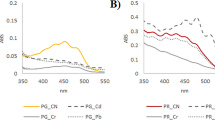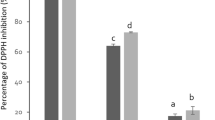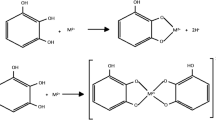Abstract
This research studies tomatoes grown in polluted soils to ascertain their phytochemical and nutritive features. Pulp and seeds from tomatoes grown in muddy soils were analyzed for their antioxidant power and their toxicity because of the possibility that heavy metals were present in the soils. An antioxidant assay on methanol extracts was made by using DDPH, while an ABTS [2,2′-Azino-bis-(3-ethylbenzthiazoline-6-sulfonic acid)] assay was used to evaluate the antioxidant activity of lipophilic fractions. Results of the antioxidant assay showed that the tomatoes maintained a high level of antioxidant activity especially in the lipophilic fractions which contain the most representative compounds. Cytotoxic activity was performed on HeLa, PDAC, and A375 cell lines by [3-(4,5-dimethylthiazol-2-yl)-2,5-phenyl-2H-tetrazolium bromide] (MTT) assay. Results showed that neither the seeds, nor the pulp, of the extracts was cytotoxic. The presence of heavy metals was evaluated by using spectroscopy of atomic absorption with a graphite oven. Test results show the absence of heavy metals and these results have an interesting scientific role because they provide useful information for promoting food safety.

Similar content being viewed by others
References
Adamo P, Iavazzo P, Albanese S, Agrelli D, De Vivo B, Lima A (2014) Bioavailability and soil-to-plant transfer factors as indicators of potentially toxic element contamination in agricultural soils. Sci Total Environ 500–501:11–22
Bertoli AC, Cannata MG, Carvalho R, Ribeiro Bastos AR, Puggina Freitas M, dos Santos Augusto A (2012) Lycopersicon esculentum submitted to Cd-stressful conditions in nutrition solution: nutrient contents and translocation. Ecotox Environ Safe 86:176–181
Blois MS (1958) Antioxidant determinations by the use of a stable free radical. Nat 26:1199–1200
Bovell-Benjamin AC (2007) Sweet potato: a review of its past, present, and future role in human nutrition. Adv Food Nutr Res 52:1–59
Caicedo M, Jacobs JJ, Redy A, Hallab NJ (2008) Analysis of metal ion-induced DNA damage, apoptosis, and necrosis in human (Jurkat) T-cells demonstrates Ni2+ and V3+ are more toxic than other metals: Al 3+, Be 2+, Co 2+, Cr3+, Cu2+, Fe3+, Mo5+, Nb5+, Zr2+. J Biomed Mater Res 86:905–913
DOUE (2006) Commission Regulation (EC) N° 1881/2006 of 19 December 2006 setting maximum levels of certain contaminants in foodstuffs. DOUE L364/5-L364/24
Dugo G, La Pera L, Lo Turco V, Giuffrida D, Restuccia S (2004) Determination of copper, zinc, selenium, lead and cadmium in potatoes (Solanum tuberosum L) using potentiometric stripping methods. Food Addit Contam 21:649–657
Fogliano V, Verde V, Randazzo G, Ritieni A (1999) Method for measuring antioxidant activity and its application to monitoring the antioxidant capacity of wines. J Agric Food Chem 47:1035–1040
Franceschi S, Bidoli E, La Vecchia C, Talamini R, D’Avanzo B, Negri E (1994) Tomatoes and risk of digestive-tract cancers. Int J Cancer 59:181–184
Giovanucci E, Ascherio A, Rimm EB, Stampfer MJ, Colditz GA, Willett WC (1995) Intake of carotenoids and retinol in relation to risk of prostate cancer. J Natl Cancer Inst 87:1767–1776
Hyun H, Chang AC, Parker DR, Page AL (1998) Cadmium solubility and phytoavailability in sludge-treated soils: effects of soil organic carbon. J Environ Qual 27:329–334
Luis G, Hernández C, Rubio C, González-Weller D, Gutiérrez Á, Revert C, Hardisson A (2012) Trace elements and toxic metals in intensively produced tomatoes (Lycopersicom esculentum). Nutr Hosp 27(5):1605–1609
Miller NJ, Sampson J, Candeias LP, Bramley PM, Rice-Evans CA (1996) Antioxidant activities of carotens and xanthophylls. FEBS Lett 384:240–242
Miner GS, Gutierrez R, King LD (1997) Soil factors affecting plant concentrations of cadmium, copper, and zinc on sludge-amended soils. J Environ Qual 26:989–994
Mohamed AE, Rashed MN, Mofty A (2003) Assessment of essential and toxic elements in some kinds of vegetables. Ecotox Environ Safe 55:251–260
Nagajyoti P, Lee KD, Sreekanth TVM (2010) Heavy metals, occurrence and toxicity for plants: a review. Environ Chem Lett 8:199–216
Ouziad F, Hildebrandt U, Schmelzer E, Bothe H (2005) Differential gene expressions in arbuscular mycorrhizal-colonized tomato grown under heavy metal stress. J Plant Physiol 162:634–649
Palacios G, Carbonell-Barrachina A, Gómez I, Mataix J (1999) The influence of organic amendment and nickel pollution on tomato fruit yield and quality. J Environ Sci Health B 34(1):133–150
Piotrowska M, Kabata-Pendias A (1997) Impact of soils amended with Zn and Pb smelter dust on Cd in potatoes. J Geochem Explor 58:319–322
Reid RJ, Dunbar KR, McLaughlin MJ (2003) Cadmium loading into potato tubers: the roles of the periderm, xylem and phloem. Plant Cell Environ 26:201–206
Rissanen TH, Voutilainen S, Virtanen JK, Venho B, Vanharanta M, Mursu J, Salonen JT (2003) Low intake of fruits, berries and vegetables is associated with excess mortality in men: the Kuopio Ischemic Heart Disease risk factor (KIHD) study. J Nutr 133:199–204
Rossato LV, Nicoloso FT, Farias JG, Cargnelluti D, Tabaldi LA, Antes FG, Dressler VL, Morsch VM, Schetinger MRC (2011) Effects of lead on the growth, lead accumulation and physiological responses of Pluchea sagittalis. Ecotoxicol 21:111–123
Schat H, Llugany M, Vooijs R, Hartley-Whitaker J, Bleeker PM (2002) The role of phytochelatins in constitutive and adaptative heavy metal tolerance in hyperaccumulator and non-hyperaccumulator metallophytes. J Exp Bot 379:2381–2392
Singleton VL, Rossi JA (1965) Colorimetry of total phenolics with phosphomolybdic-phosphotungstic acid reagents. Am J Enol Vitic 16:144–158
Tommonaro G, De Prisco R, Abbamondi GR, Marzocco S, Saturnino C, Poli A, Nicolaus B (2012) Evaluation of antioxidant properties, total phenolic content, and biological activities of new tomato hybrids of industrial interest. J Med Food 15(5):483–489
Tommonaro G, De Prisco R, Abbamondi GR, Nicolaus B (2013) Bioactivity of tomato hybrid powder: antioxidant compounds and their biological activities. J Med Food 16(4):351–356
Tommonaro G, Caporale A, De Martino L, Popolo A, De Prisco R, Nicolaus B, Abbamondi GR, Saturnino C (2014) Antioxidant and cytotoxic activities investigation of tomato seed extracts. Nat Prod Res 28(10):764–768
Vainio H, Weiderpass E (2006) Fruit and vegetables in cancer prevention. Nutr Cancer 54:111–142
Verkleij JAC, Golan-Goldhirsh A, Antosiewisz DM, Schwitzguebel JP, Schroder P (2009) Dualities in plant tolerance to pollutants and their uptake and translocation to the upper plant parts. Environ Exp Bot 67:10–22
Wawrzynski A, Kopera E, Wawrzynska A, Kaminska J, Bal W, Sirko A (2006) Effects of simultaneous expression of heterologous genes involved in phytochelatin biosynthesison thiol content and cadmium accumulation in tobacco plants. J Exp Bot 57:2173–2182
Weyens N, van der Lelie D, Taghavi S, Vangronsveld J (2009) Phytoremediation: plant–endophyte partnerships take the challenge. Curr Opin Biotechnol 20(2):248–254
Acknowledgments
The authors thank Dr. Essolito Massimiliano and Dr. De Martino Francesco of the University of Salerno for the atomic absorption spectroscopy analysis. This work was supported by a dedicated grant from the Italian Ministry of Economy and Finance to the National Research Council for the project “Innovazione e Sviluppo del Mezzogiorno, Conoscenze Integrate per Sostenibilita’ ed Innovazione del Made in Italy Agroalimentare, Legge n. 191/2009.”
Author information
Authors and Affiliations
Corresponding author
Additional information
Responsible editor: Philippe Garrigues
Rights and permissions
About this article
Cite this article
Tommonaro, G., Nicolaus, B., De Prisco, R. et al. Evaluation of heavy metals, cytotoxicity, and antioxidant activity of tomatoes grown in toxic muddy soils. Environ Sci Pollut Res 22, 5756–5761 (2015). https://doi.org/10.1007/s11356-014-3861-0
Received:
Accepted:
Published:
Issue Date:
DOI: https://doi.org/10.1007/s11356-014-3861-0




